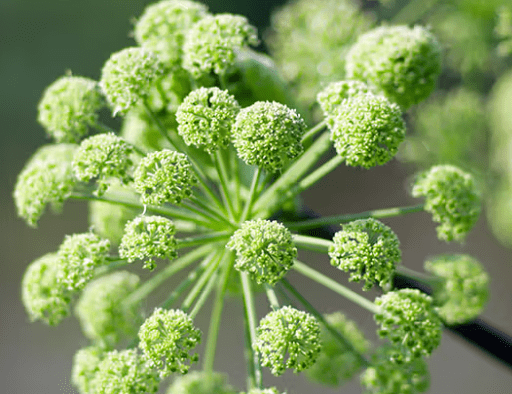
The angelica plant belongs to the parsley family and is closely linked to carrots. Although the plant’s leaves are plain and boring, they can be dried and used to teas or other dishes as a flavoring. Though only seen every two years, the umbrella-like flowers are stunning and the plant frequently dies after blooming. When the blossoms are gone, each spoke of the white umbels contains a dangling seed. Known for its sweet flavor and strong musky aroma, angelica herb can be found in some of your favorite spirits. The seeds, leaves, and root are all beneficial. In its first year, angelica is a basic rosette with a tiny stalk that can reach a height of one to three feet.
After one year, the plant drops its rosette structure and sprouts larger leaves with three sections and a stalk that can reach a height of 4 to 6 feet. The thick, fleshy root, which is frequently utilized, resembles a large, pale carrot.
Habitat
Angelica sylvestris is found across Britain and Ireland, with the exception of extremely arid areas in the southeast, where it is rarely discovered. Originally from Europe and Asia, this plant can now be found in eastern North America, although it is regarded as an invasive weed there.
Uses
In Southwest Asia, plants in the genus Angelica are referred to as “women’s ginseng” and are used to treat vascular dystonia, amenorrhea and dysmenorrhea, menopausal problems, hypertonia, and anemia. These plants are recognized as medicinal in numerous countries.

Major Species
The common angelica, Angelica archangelica, has lime green flower heads and pinkish stems.
Angelica gigas: Also known as Korean angelica, this plant is more decorative and has summertime blooms that are a deep purple colour.
Angelica sylvestris: This kind of angelica is smaller than other varieties and has a softer scent. It grows wild.
Plant Care
- Light
Angelica’s light preference is dependent on the climate. Because it is a native of colder regions, angelica loves cooler, wetter soils. It is a good idea to position your angelica in an area that receives partial shade if you live in a warm climate. This herb need full sun to grow in cooler climates.
- Soil
Angelica can grow in a wide range of soil types; its only strict need is that the soil be damp. Apart from that, practically any kind of soil will do, however it prefers slightly acidic soil (pH no more than 7.0). Your plant shouldn’t suffer unless the soil is too alkaline; you can quickly test the pH of the soil and make any necessary amendments.
- Water
You may need to water your angelica patch more frequently if it is not situated in an area that receives regular moisture from adequate rainfall or runoff. The soil around your herbs should be somewhat moist but not soggy at all.
- Temperature and Humidity
Most of the time, angelica’s natural temperature range is cool. Your angelica should thrive if you reside in USDA Zones 4–7.
- Fertilizer
You don’t need to fertilize your angelica, unlike most other herbs. Although it might be helpful, you should only mix in a small amount of compost to the area where you intended to plant.
Table





